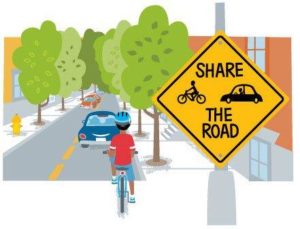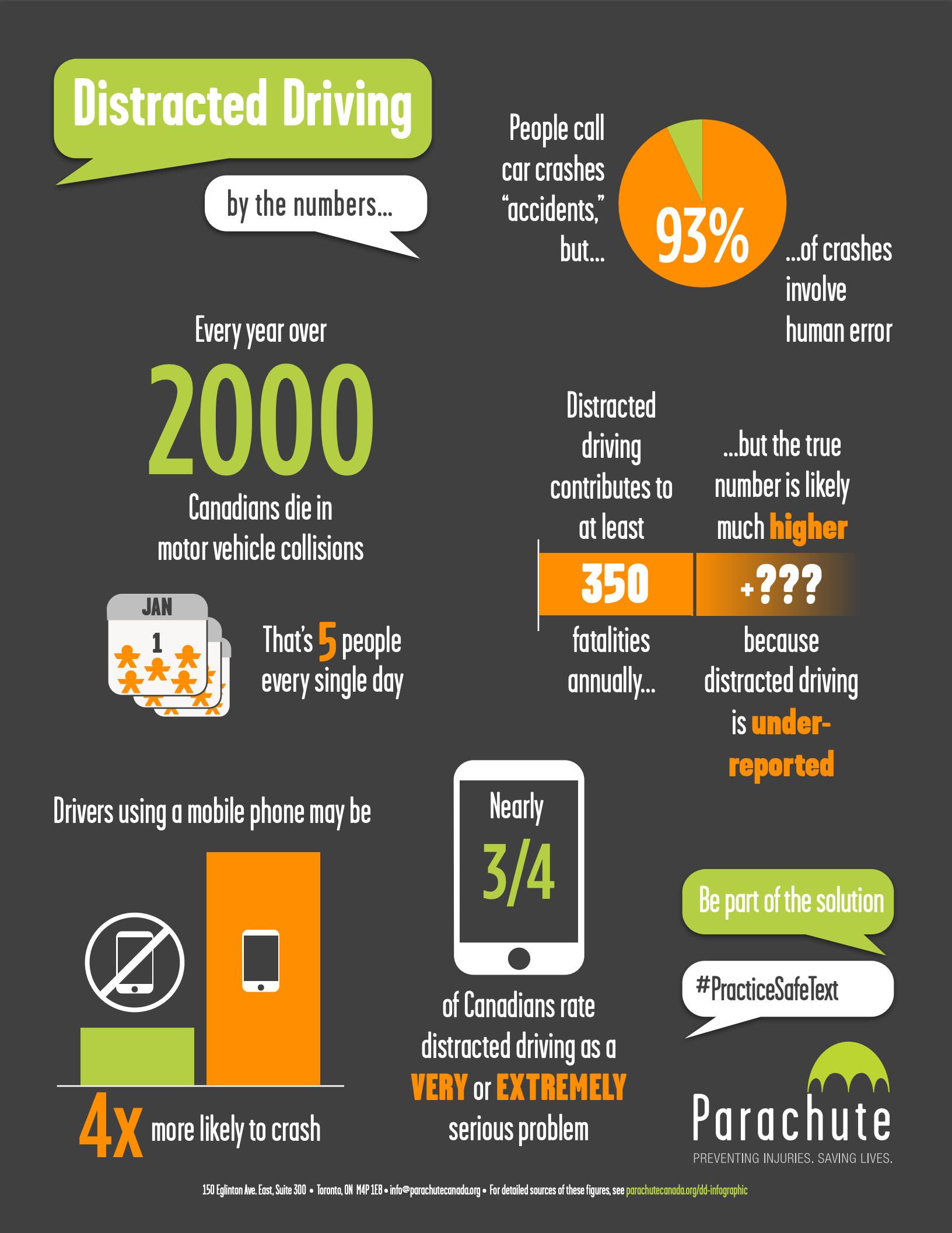CK Public Health works in promoting road safety and preventing injuries. CK Public Health does this by:
- Working in partnership with community organizations to support and develop safety related resources, events and campaigns
- Raising awareness about risk factors for injury
- Informing the general public of how to reduce the risks
- Promoting strategies and policies for injury prevention
School Bus Safety
School Bus Safety 2022 Presentation
Cycling
 Cycling is one of the healthiest and most environmentally friendly ways to get around town. Cyclists have the same rights and responsibilities as other drivers on the road and it is important to make sure all road users feel safe. To feel more confident and safe when cycling, visit Bicycle Safety on the Ontario Ministry of Transportation website and Chatham-Kent Safe Cycling.
Cycling is one of the healthiest and most environmentally friendly ways to get around town. Cyclists have the same rights and responsibilities as other drivers on the road and it is important to make sure all road users feel safe. To feel more confident and safe when cycling, visit Bicycle Safety on the Ontario Ministry of Transportation website and Chatham-Kent Safe Cycling.
Remember that it is always important to wear your helmet when cycling. By law, it is required for anyone under 18-years old and strongly recommended for everyone else.
You can find out more about Chatham Kent Bike Routes by clicking here.
To view our safe cycling videos in partnership with Parks and Open Spaces, CK Public Health, RU SAFE CK and Chatham-Kent Trails, please click on the links below.
Safe Cycling; riding a safe bike
Safe Cycling: using a bike lane
Pedestrian safety
In Canada, pedestrian injuries are one of the leading causes of injury-related deaths for children 14 years of age and younger. While there has been a 54-per-cent decrease in pedestrian fatalities in children ages 0 to 14 years between 2005 and 2014, each death remains a tragedy – most often a preventable one. Injuries to child pedestrians are often severe. They may be left with long-term disabilities, emotional strain and financial burdens that can last a lifetime.
Many Canadian communities are taking an interest in promoting walking, both for its health benefits and as a “green” initiative. In some communities, this has led to a renewed family enthusiasm for walking to school. It is vital to encourage parents and caregivers to talk to children about pedestrian safety during these walks. It is equally important to create more walkable communities that promote safe, pedestrian-friendly environments. Increased pedestrian numbers actually heighten driver awareness, which can result in slower rates of speed and fewer child pedestrian injuries.
General pedestrian safety tips: Distractions put pedestrians at a much higher risk of being struck by a vehicle. Make it a rule not to use cell phone, or other hand-held electronics while walking, and especially not while crossing streets.
Learn more about pedestrian safety by visiting the Ontario Ministry of Transportation website.
Source: Parachute Canada
Distracted Driving
Distraction is an issue amongst all Canadian drivers. It can be defined as anything that takes a driver’s attention away from the task at hand. These distractions can be classified into three categories: visual, manual and cognitive.
Visual distraction: When a driver’s eyes leave the road way
Manual distraction: When a driver’s hands leave the steering wheel
Cognitive distraction: When a driver’s mind is no longer on the task at hand
These distractions can seem like a minor moment of inattention, but still detract from an important task. Handheld devices present high levels of risk amongst drivers. Other distractions include drinking, adjusting dials in the car, eating, personal grooming, turning around, reaching for something in vehicle and communicating with people inside or outside the vehicle. The addition of passengers further distracts drivers, through loud conversations and horseplay.
In addition to the type of distraction, it is also important to recognize that distractions can have various origins.
- Internal: These distractions come from within the car or the driver’s mind (originating from passengers, thoughts, etc.)
- External: These distractions originate outside the car, such as other vehicles, signs, weather, etc.
It is important to manage distractions before getting on the road!
These tips are a great start to staying safe behind the wheel:
- Either mute or turn off cell phones before leaving, storing them away to avoid usage
- Use car controls responsibly and maintain awareness of the roadways
- Do not eat, drink or groom yourself while driving
- Follow laws and regulations where you are driving
- Ensure you are aware of your surroundings.
- Become a role model for passengers in your vehicle.
Source: Parachute Canada
Find out more about distracted driving from the Distracted Driving FAQs section of the Ontario Ministry of Transportation website.
Impaired Driving
Alcohol or drugs: Impaired is impaired
Many drugs, even those prescribed by a doctor or purchased over-the-counter, can impair your ability to drive safely. For example, smoking, vaping or eating cannabis can increase your risk of being involved in a motor vehicle collision. If you are unsure of whether it is safe for you to drive while taking your medication, talk to your doctor or pharmacist.
The Canadian Society of Forensic Science recently released a report stating that impairment from cannabis begins almost immediately and can last up to 6 hours or more, depending on factors such as THC levels and how it is consumed. Frequent high-dose THC users may experience even longer periods of impairment. However, since the effects of cannabis vary, there is no way to know exactly how long to wait before it is safe for you to drive. The best way to avoid impaired driving is to not take a chance. If you’re using cannabis, plan another way home.
Alcohol — even one drink — can reduce your ability to react to things that happen suddenly. The effects of alcohol also include blurred or double vision, impaired attention and slowed reflexes. Alcohol-impaired driving is one of the leading causes of death on Ontario’s roads.
Tips to avoid impaired driving
There are simple steps you can take to avoid driving while you’re impaired by drugs or alcohol:
- Have a plan to get home safely. Have a designated driver, use public transit, call a friend or family member for a ride, call a taxi or ride share, or stay overnight.
- Ask your doctor or pharmacist about side effects related to driving when using prescription medication.
- Read the information on the package of any prescription drugs or over-the-counter medicine, including allergy and cold remedies.
- Ask your doctor or pharmacist about how a prescription drug could affect you. Remember that combining drugs and alcohol together can impair your ability to drive more than using either one alone.
Source: Ministry of Transportation
For more information about impaired driving and tips on how to avoid impaired driving, visit the Impaired Driving section of the Ontario Ministry of Transportation.

Seatbelts
In 2015, nearly 30% of Canadian drivers and passengers died in a collision where they were not using a seatbelt. Not only are you more likely to survive a crash when wearing a seatbelt, but you can be fined if you or any passengers under 16 are not wearing one. Ensure your vehicle has one seatbelt for each person and that everyone is wearing one. Buckle up!
Visit the Safe Driving Practices section of the Ontario Ministry of Transportation website to learn more about seatbelts and how to wear them properly.
For Further Information
Contact the Injury Prevention Program Email: lisat@chatham-kent.ca or phone: 519.352.7270 ext. 2453



